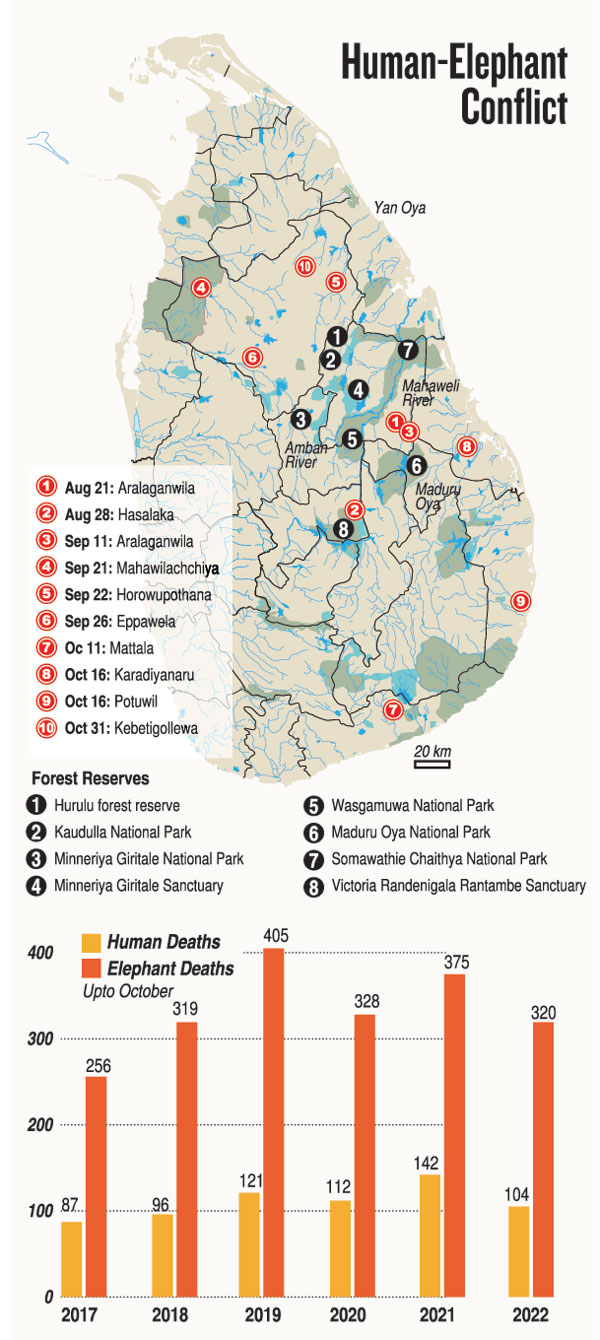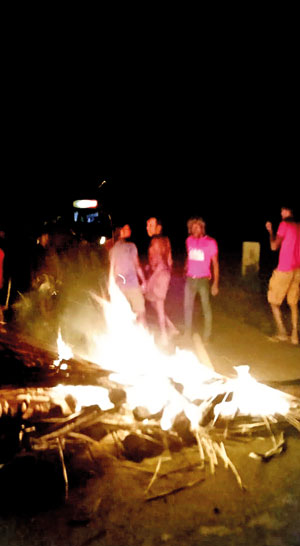News
Dearth of wildlife officers and other factors cited for wild elephant attacks
View(s):By Senuka Jayakody
Department of Wildlife Director General Chandana Sooriyabandara, told the Sunday Times there are only about 1,000 wildlife officials.
On Monday, in Kebithigollewa, a villager died from a wild elephant attack and angry villagers said wildlife officers had not responded after they had been told by phone about wild elephants in the area. Villagers said the wildlife officers had said there was no one to send and they also did not have a vehicle. The man’s death triggered unrest and a policeman also lost his life.
Mr Sooriyabandara said most jobs in the Wildlife Department are labour intensive, but only a 1,000 staff are available. He also blamed the human-elephant crisis on factors such as the Yan Oya Project, where promised fencing had not been built.
The Wildlife Department has hosted 300 programmes within two years to educate people, to help them avoid certain roads, and times. These have been successful in Puttalam and Sinharaja. However, Mr Sooriyabandara said people do not always follow advice. “Most elephant attack cases reported to us are where the victim was drunk, travelled during unsuitable times, or has travelled unsafely, without even a torch light. We have done everything we can. There is nothing more new to do.’’
The All Island Combined Wildlife Officers Union President Prabash Karunathilake complained of having fewer than 1,000 staff.
“Provide a wildlife official each for five problematic Grama Niladhari divisions, and the problem will be solved,’’ he said.
Mr Karunathilake said the Yan Oya Project had displaced elephants. Authorities had been warned of this, but ignored warnings.
BioDiversity Conservation and Research Circle convenor Supun Lahiru Prakash said elephants that escaped the Horowpathana holding area roam the villages.
Around 100 elephants were translocated to the Horowpathana holding area in 2013, from which some elephants escaped, while some died from malnutrition. Only about six elephants remained. The elephants that escaped are now roaming in areas, including Kebithigollewa.
“The human-elephant conflict also concerns humans. The Wildlife Department is only for wild animals. Human welfare organisations are also related to the issue,’’ Mr Prakash said. He proposed the long-delayed implementation of the Human-Elephant Conflict Mitigation Action Plan, drawn up in 2020. This involves stakeholders, including the Forestry Department, the Irrigation Department, and the Wildlife Department.
He also highlighted the lack of wildlife officials. There are fewer than 1,000 officials. There are about 6,000 wild elephants. According to Mr Prakash, elephants roam on 60% of the land area, of which 20% is forest reserves, while 40% is shared with humans, causing the current conflict. Every day an elephant is killed and three people are killed every week. Polonnaruwa District Secretary, W A Dharmasiri, said 100 km of electric fencing has been built, but there are no officers to protect the fences.
In the Polonnaruwa District, he states that 51% of the area is forest, with major forest reserves such as Somawathi, Minneriya and Kawudulla, while villages are on the borders of the reserves, risking frequent elephant attacks.
The Minipe Divisional Secretary, Nuwan Henakumara said there are only four wildlife officials and one vehicle for the wildlife office in the area, which consists of 45 divisions.
The Divisional Secretariat is setting up committees in each village, to understand the paths that elephants take to help raise awareness.
‘Shramadana‘ work is carried out to clear small forest areas on either side of roads. The Government is providing Rs 25,000 to those who have suffered property damage through the Divisional Secretariat. Also, Rs 1 mn compensation is paid for a death,of which Rs 100,000 is paid for a funeral.
“We cannot minimise the harm from elephants 100%,” he said. Electric fences have been erected in the Hasalaka area. Mr Henakumara believes that deforestation and the Moragahakanda Project may have caused the dislocation of elephants.
The Mahiyangana Divisional Secretary, Sanjaya Weerasinghe, said the danger of wild elephant attacks are ever present considering the three bordering forest reserves. “This is originally elephant habitat, which people have settled in.’’
Mr Weerasinghe said elephant raids into villages have increased now that the paddy harvest is being stocked in homes.
Former Wildlife Minister, Wimalaweera Dissanayake told the Sunday Times that his plan to introduce new technology and electric fences to “help both humans and elephants”, was opposed by NGOs.
“People die everyday from elephant attacks but nobody blames the minister, unlike when I was in office. I will never accept the ministry if it is given to me,’’ he said.

| Protection assured in Kebithigollewa after unrest Guard posts are to be set up in the village where a deadly attack by a wild elephant had led to violence in which a policeman was killed. The Kebithigollewa Divisional Secretariat has had talks with the police, army and the civil defence department and decided to set up guard posts with the support of the villagers.  The killing of a villager by an elephant led to unrest The killing of a villager by a wild elephant on the night of October 31 had led to the unrest when the Medawachchiya wildlife officers in charge of Kebithigollewa had been at Wahalkada. A villager who had got off a bus at 7:30pm, had been fatally attacked in a paddy land by a wild elephant. His death then had led to a protest involving 300 to 400 villagers. They had also blocked the road and set tires alight. The police had tried to control the protest, at which the villagers are alleged to have beaten up police sergeant, Mr A P Sunil. During the incident, the other policemen fired into the air to hold back the crowd. The policeman died on the way to the Anuradhapura Hospital. Later, the police arrested 20 suspects including a Buddhist monk with whom the police have had a cordial relationship. One woman who was not a suspect was released, while the rest were produced in court and remanded until November 10. The policeman was posthumously promoted to sub-inspector by the senior deputy inspector general for dying in the line of duty. His funeral was held on Thursday at Wariyapola. | |
The best way to say that you found the home of your dreams is by finding it on Hitad.lk. We have listings for apartments for sale or rent in Sri Lanka, no matter what locale you're looking for! Whether you live in Colombo, Galle, Kandy, Matara, Jaffna and more - we've got them all!

